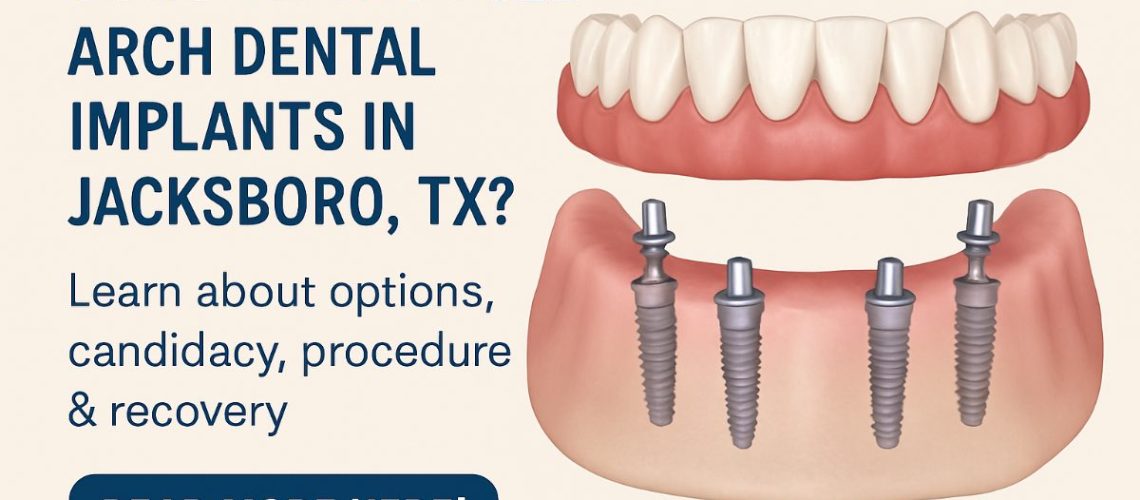If you’re exploring options to replace a full set of teeth, this guide covers what to expect with full arch dental implants by Jacksboro, TX. You’ll learn who benefits from full-arch solutions, how they differ from dentures, the steps from evaluation through recovery, and practical next steps. Search terms like full arch dental implants jacksboro tx often bring patients to consults where they weigh speed, cost, and long-term results.
What Are Full-Arch Dental Implants?
Full-arch dental implants replace an entire upper or lower row of teeth using implants anchored in the jaw. Instead of one implant per tooth, a few implants support a fixed or removable prosthesis. Common names include All-on-4, All-on-6, and implant-retained dentures. These restorations offer far better stability, chewing ability, and appearance than traditional dentures.
Who Is a Good Candidate for Full-Arch Dental Implants?
General Health and Oral Health Factors
Good candidates are generally healthy enough for outpatient surgery and committed to oral care. Uncontrolled diabetes, heavy smoking, active oral infections, or certain immune disorders can affect healing and candidacy. Your surgeon will review medical history, current medications, and habits during the consult.
Bone Volume and When Grafting Is Needed
Bone loss can limit implant sites. Some patients need bone grafting to rebuild volume before final implants. In severe upper-jaw loss, zygomatic implants (anchored in cheekbone) can avoid grafting. Modern planning helps determine if grafting is necessary or if immediate implants are possible.
Types of Full-Arch Solutions
Full-arch treatment ranges from same-day, immediate-load prostheses to staged approaches. Immediate-load (same-day) options let many patients leave with provisional teeth the day of surgery. Staged approaches may place implants and wait for healing before fitting the final prosthesis. All-on-4 uses four implants, All-on-6 uses six for extra support, and zygomatic implants are used when upper jaw bone is insufficient.
What to Expect During the Treatment Process
Consultation and 3D Imaging
Your initial visit includes medical review and 3D CBCT imaging to map bone, nerves, and sinuses. Digital impressions and virtual planning create a surgical plan that reduces surprises and improves safety.
Surgical Day and Immediate Temporaries
Sedation options range from oral sedation to IV anesthesia. Surgery typically takes a few hours depending on extractions and implants. Many practices provide provisional teeth the same day so you have function and appearance while healing.
Making the Final Prosthesis
After healing (usually a few months), the final prosthesis is fabricated—common materials include hybrid (acrylic over metal) or high-strength zirconia. Final adjustments ensure fit, bite, and comfort before permanent placement.
Recovery, Aftercare, and Long-Term Maintenance
Initial recovery often includes swelling and discomfort for several days; pain is usually managed with prescribed or over-the-counter medications. Diet moves from liquids to soft foods, then to normal foods over weeks. Daily cleaning around implants and regular check-ups help prevent complications and extend implant life.
Risks, Complications, and How They’re Minimizing
Possible risks include infection, implant failure, nerve irritation, and sinus issues. These risks are lowered with thorough planning, 3D imaging, guided surgery, sterile technique, and experienced surgeons. Early detection and maintenance visits also reduce long-term problems.
Cost Factors and Financing Options
Price varies with the number of implants, need for grafting or extractions, prosthetic material (zirconia costs more than acrylic), lab work, and sedation choice. Many practices offer third-party medical financing options, in-house payment plans, and help navigating dental insurance (often partial coverage). Be cautious of price-only decisions—experience and technology matter for predictable results.
Why Advanced Technology Matters for Full-Arch Work
Digital tools improve predictability and speed. CBCT scans map anatomy, dynamic guidance provides real-time implant navigation, in-house milling and 3D printing speed up provisional and final prostheses, and photogrammetry plus digital scans ensure precise fits. These technologies reduce time in surgery and improve outcomes.
How to Choose a Provider for Full-Arch Dental Implants Near Jacksboro, TX
Look for board-certified oral and maxillofacial surgeons or implant specialists with documented full-arch experience and before/after photos. Ask about same-day full-arch cases, digital workflows, on-site labs, and sedation options. Confirm who will handle follow-up care and emergencies.
About Texas Center for Oral Surgery & Dental Implants (Light Practice Mention)
Texas Center for Oral Surgery & Dental Implants offers board-certified surgeons, single-day full-arch capabilities, and an in-house digital lab. They use advanced tools like dynamic guidance and onsite zirconia milling to deliver care for patients seeking full arch dental implants by Jacksboro, TX while providing concierge-level support for patients and referring dentists.
Next Steps & Patient Checklist
- Gather medical history, current medications, and any imaging.
- List priorities: speed (same-day), cost, permanence, or esthetics.
- Prepare questions: experience, success rates, materials, and recovery.
- Schedule an evaluation or request a referral for full arch dental implants by Jacksboro, TX.
Frequently Asked Questions
How long do full-arch implants last?
With proper care, implants can last decades. Prostheses may need periodic maintenance or replacement of parts.
Is the procedure painful?
Surgery is done under sedation or anesthesia; discomfort afterward is common but manageable with medication and tends to improve quickly.
How soon can I eat normally?
Many patients eat soft foods the first few weeks and return to a broader diet after healing—final prostheses allow full chewing once fully integrated.

